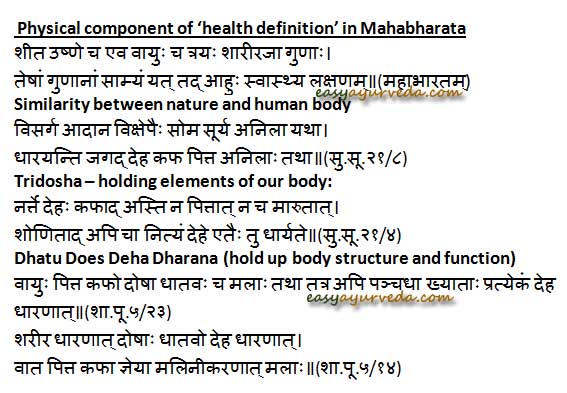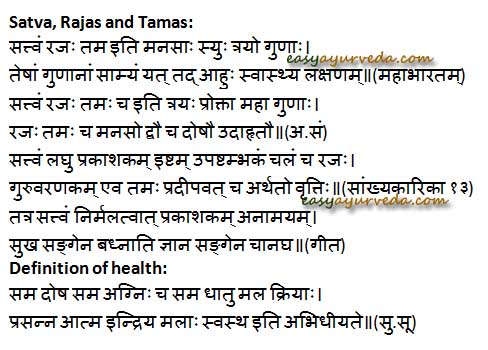References Of Health And Ayurveda In Mahabharata
Article by Dr Manasa, B.A.M.S
Ramayana and Mahabharata are the greatest Indian Epics of Indian literature written in Sanskrit. It is an epic narrative of the Kurukshetra war including the battle between the Pandava and Kaurava princes. It is translated as ‘The great tale of the Bharata Dynasty’.
Mahabharatha is not just a story, it also contains many philosophical preaching’s and devotional material including the 4 chief goals of life or Purusharthas.

Table of Contents
Bhagavad Gita
Bhagavad Gita is one of the segments of Mahabharat which has been highly worshiped and valued. It comprises of philosophical preaching done by Lord Krishna to Arjuna, the Pandava Prince to enlighten him to take up the battle against bad and evil. It helps us to lead a moral way of living.
The story of Damayanti and abbreviated version of Ramayana and the Rishyasringa are other important parts of Mahabharata.
Vedavyasa
Vedavyasa is supposed to be the author of Mahabharata. The oldest preserved parts of the text are thought to be not much older than around 400 BCE, though the origins of the epic probably fall between the 8th and 9th centuries BCE.
The Mahabharat is the longest known epic poem. It is also described as ‘the longest poem ever written’. Its longest version consists of over 100,000 shlokas and long prose passages. It comprises of about 1.8 million words in total. It is roughly 10 times the length of the Iliad and the Odyssey combined or about 4 times the length of the Ramayana.
W.J.Johnson has compared the importance of Mahabharath in the context of world civilization to that of the Bible, the works of Shakespeare, the works of Homer, Greek drama or the Qur’an.
Different types of personalities and their psychology, socio-economic and political conditions of that period can be seen described in Mahabharata. It gives us the complete picture of the art and culture of that period and it can be called ‘Encyclopaedia of Bharata Khanda’.
Mahabharata is one of the greatest Indian Epics and longest known epic poem (Mahakavya), the other one being Ramayana. It narrates the story of Pandava and Kaurava Princes, and the battle of Kurukshetra. Mahabharata also comprises in it the philosophical preaching, moral ways of living and teachings of humanity as taught by Lord Krishna in the form of Bhagavad Gita Upadesha as done to Arjuna.
Mahabharata is supposedly written by Veda Vyasa and is said to be composed between 8th and 9th centuries BCE. Though many evidences suggest it happened much previously.
Ayurveda in Mahabharatha
It is not surprising to find excerpts and references of Ayurveda, its branches, medicines and practice of medicine in Mahabharata, Ayurveda being a part of each milestone of evolution.
Subject materials related to Ayurveda and various types of medicinal and surgical methods explained in Ayurveda can be seen referred to in Mahabharata.
One can also find the reference and description of Ashtanga Ayurveda – 8 branches of Ayurveda in Mahabharata.
Read related: References Of Health And Ayurveda In Ramayana
Medicinal Practice
We can find a reference in Mahabharata wherein Sage Narada Maharshi enquires Yudhishtara (elder brother of Pandavas) about his health status and quizzes him as ‘Oh! Yudhistara, how is your health? Are you getting proper treatment or not? By adopting Satsanga (circle of good, like-minded and compatible people) and Sadachara (noble deeds), the psychological disorders can be prevented. By taking the wholesome diet, most of the disorders occurring to the body (somatic disorders) can be prevented. Whether the Royal physicians are well versed in Ashtangas or not?’
This reference shows that the medicinal practice already existed in those days. One can also see that Satsanga (explained as Sadvritta in Ayurveda), Sadachara and Ashtanga are mentioned in the above said context, which directly refers to Ayurveda.
Toxicology
References related to Visha Chikitsa or Toxicology
Kashyapa and Takshaka incident – Kashyapa was an expertise in toxicology. The discourse between Takshaka (king of serpants) and Kashyapa is a proof of Kashyapa’s brilliance in toxicology. Kashyapa is said to have revived the Banyan tree which was reduced to ashes by Takshaka.
Divine Toxicology – Practice of divine therapy in toxicology was also seen in Mahabharata.
Parikshit incident – Once, King Parikshit was affected by a snake bite. Later he had called upon the physicians who were experts in the field of toxicology to attend him.
Poisoning of Bhima – Once, Duryodhana, the elder Kaurava Prince administered poisonous food to Bhima, the middle brother of Pandavaas. When Bhima had become unconscious as a result of consuming the poisoned food, Duryodhana had him thrown into a river. Later, Bhima was survived and revived due to the bite of a serpent. This suggests that a Jangama Visha (animal poison) might have acted as an antidote to Sthavara Visha (plant poison).
Brahma and toxicology – In Mahabharata, various types of serpents have been described. It is stated that Lord Brahma, the creator himself, taught Toxicology to Kashyapa.
Waking up the dead
Mritasanjivani Vidya
One can find a story ‘Kacha-Devayani’ in Mahabharata. It tells that Brihaspati sent his son Kacha to Shukra, for learning ‘Mritasanjivana Vidya’, the treatment which can resuscitate those who are almost dead.
Diseases, Causative factors and Treatment
In the ‘Shantiparva’ section of Mahabharata, the psycho-somatic disorders and their clinical picture are described along with the influence of Trigunas (Satva, Raja and Tama) on the body and mind, in a similar way as found explained in Ayurveda.
Ashwins, the celestial-physician-duo treated the blindness of Upamanya, which was caused due to the consumption of Arka leaves (Caltrops)
Atriputra suffered from Rajayakshma (tuberculosis, wasting disease, phthisis), caused due to excessive copulation. He was later revived by proper administration of treatment.
Test Tube Baby
References of Test Tube Baby
During her pregnancy, Gandhari, the queen of Hastinapura and mother of Kauravas, beat herself on her abdomen which resulted in abortion. The pieces were kept separately; each piece in a separate earthen pot containing ghee, for a period of ten months, as a result engendered one child from each preserved piece.
The zygotes formed in the uterus of Kadruva and Vinata were kept in an earthen pot containing ghee, gave birth to children. We can infer that the formation of test tube baby was already in practice from these available references.
Influence of Mother’s feelings on the baby
It is said that Ambika (mother of Dritharashtra, the blind king of Hastinapura and father of Kauravas) closed her eyes out of fear at the time of intercourse; she gave birth to Dritharashtra who was blind at birth. With this incidence one can infer that the feelings of the mother can reflect over the progeny. (We also have a different reference of this incident which tells that Ambika closed her eyes as she could not see the glow emitted by a sage and as a result, Dritharashtra was born blind).
Reference of Surgical Practice
When Bhishma, the commander-in-chief of Kauravas (grandfather to both Kauravas and Pandavas) was wounded and was lying on the bed of arrows during the Kurukshetra war, Duryodhana called experienced and skilled surgeons to treat Bhishma. But heroic Bhishma refused to take any treatment, as he wanted to die on the bed of arrows as a true Kshatriya (warrior). This suggests that military surgeons and practice of surgery also existed in those days.
Excessive use of Ghee in Yagna, Yagas (fire sacrifices) results in Ajirna (indigestion) to Agni Deva (fire God) and he was relieved only after the forest fire burnt various herbs and trees present in the Kandava Forest.
Definition of Health
Definition of Swasthya or Comprehensive Health in Mahabharata
Ayurveda was the first medical science to have given a comprehensive definition of health, covering both physical and mental well being as components of the health.

The reference for ‘definition of swaasthya’ in Mahabharata is as mentioned below. The explanation is similar to the definitions of health as explained in Ayurveda.
Physical component of health
- Physical component of ‘health definition’ in Mahabharata
Mahabharata explains swaasthya or health in terms of Sheeta, Ushna and Vayu.
Meaning –
‘Sheeta or cold (coldness), Ushna or heat and Vayu or air, are the three Gunas (qualities, elements, humors) of the body. When there is Saamya or a state of equilibrium (balance) amongst these 3 elements in a being, he or she is said to be in a state of Swaasthya (healthy)’
Ayurveda has also considered the equilibrium of the same 3 elements i.e. sheeta, ushna and vayu for the body to enjoy a comprehensive health or swasthya. The human body, according to Ayurveda is said to be a miniature nature and represent in itself the whole representation of the bigger cosmos. Thus, each physical body is a microcosm and is essentially derived from and belongs to the greater macrocosm. Ayurveda has given the concept of ‘Prakriti-Purusha Samya’ i.e. similarities between the nature (creation) and human body (created).
Just like the Soma (moon), Surya (Sun) and Anila or Vayu (Air) control the nature by controlling the Visarga (cold season or energy giving), Adana (hot season or energy sapping) and Vikshepa (airy season or moderate season having equal distribution of heat and cold) Kalas respectively, the Kapha, Pitta and Vata adorn and control the human body and the functions therein.|
This means to tell that just as the Soma is responsible for Visarga karma in the macrocosm, Kapha does visarga karma (coolant, buffer and protective functions) in the microcosm of human body. Just as the Surya is responsible for Aadana karma in the macrocosm, Pitta does the aadana karma (heat related activities, metabolism) in the microcosm of the human body. Just as the Anila or Vayu is responsible for Vikshepa karma (distributive property) in the macrocosm, the Vayu does the vikshepa karma (distribution functions and balancing act, runs the body and mind activities undisturbed in a state of balance) in the microcosm of the body.
Read related: Ayurvedic Definition of health – WHO vs Ayurveda
Here,
- Kapha – is a water component of the human body, represents the Soma (moon) and Sheeta (coldness as mentioned in Mahabharata). Kapha and Soma too are cold in nature.
- Pitta – is a fire component of the human body, represents the Surya (Sun) and Ushna (heat as mentioned in Mahabharata). Pita and Surya too are hot in nature.
- Vayu / Vata / Anila – is the air component of the human body, represents the Vata (air) and Vayu (air as mentioned in Mahabharata). Vata and Vayu are airy in nature.
The equilibrium or balance of these 3 components is essential for maintenance and sustenance of Swasthya or good health. Ayurveda names these 3 humors i.e. Vata, Pitta and Kapha as Tridoshas. The Vayu, Ushna and Sheeta mentioned by Mahabharata as inevitable factors whose equilibrium is mandatory for good health correspond with Vata, Pitta and Kapha mentioned in Ayurveda respectively. Just like the pillars support the house or a building, Vata (Vayu), Pitta (Ushna) and Kapha (Sheeta) when present in a state of equilibrium or saamya, jointly support the home called human body.
According to Sushruta, ‘No organism can exist without Kapha, Pitta, Vata and Rakta (blood) because the body is supported by these three elements.’
The body is a unique system wherein all the contrasting elements i.e. water (kapha, sheeta), fire (pitta, agni, ushna) and air (vata, vayu) are operating at a time. They don’t meddle with each other’s functions and carry on the activities of the body and mind in a comprehensive way, provided they are not disturbed. In fact, in a state of equilibrium, they complement each other’s functions. If these components are disturbed due to various causative factors including erratic lifestyle practices, incompatible diet, stress, forcible withholding of body urges etc, they tend to contaminate the body elements including tissues and cause various diseases including loss of immunity. When disturbed they also tend to disturb each other. Therefore they need to stay in a state of equilibrium.
Vata, Pitta and Kapha are not only doshas, they are also considered as dhatus and malas (metabolic wastes). This depends on whether they are rendering constructive activities or destructive activities (as when they get vitiated and cause diseases), whether they are in a state of equilibrium or whether they are disturbed. When these 3 elements i.e. Vata (Vayu), Pitta (Ushna) and Kapha (Sheeta) get vitiated and tend to damage the body, they are termed as doshas. When the same elements are in a state of balance and render the body activities normally and sustain the body, are protective in nature, they are called dhatus (act like tissues). When these elements vitiate the body and body elements, contaminate and damage them by not getting expelled from the body, cause blocks in the system, they are called malas (contaminants, excreta, endo-toxins).
Seeing these resemblances, it can be concluded that the Vayu, Ushna and Sheeta mentioned by Mahabharata in the definition of health are the same as Vata, Pitta and Kapha mentioned in Ayurveda.

Mental component of health
- Mental component of ‘health definition’ in Mahabharata
In the above said verse, Mahabharata explains swaasthya or health in terms of Sattva, Rajas and Tamas which are the qualities of the Manas or Mind.
Meaning –
‘Sattva, Rajas and Tamas are the 3 Gunas (attributes) of the Manas (mind). When there is Saamya or a state of equilibrium (balance) amongst these 3 elements in a being, he or she is said to be in a state of Swaasthya (healthy)’
Mahabharata has dealt the definition of health in 2 split sections –
- A physical component of health which depends on the equilibrium of Vayu, Ushna and Sheeta
- A mental component of health which depends on the equilibrium of Sattva, Rajas and Tamas
It cannot be clearly said if Mahabharata had considered the body and mind components together to define a comprehensive health or have given individual importance to both. Mahabharata might have meant that either physical or mental components have to be in a state of equilibrium for a person to be enjoying good health.
But Ayurveda has always defined body and mind health as a comprehensive unit.
Read related: References Of Health And Ayurveda In Mahabharata
Definition of Swasthya
we can see that Swastha or healthy person is defined as a person who has Sama Dosha (equilibrium of Vata, Pitta and Kapha), Sama Agni (balanced state of metabolism), Sama Dhatu (equilibrium of tissues in terms of quality and quantity), Sama Mala Kriya (timely and proper elimination of waste substances of the body) and a Prasannatva of Atma, Indriya and Mana (state of balance or pleasantness of soul, senses and mind).
Here we can see that Ayurveda has given importance to both Sama Dosha and Prasanna Manas (equilibrium of Sattva, Rajas and Tamas) in the definition of Ayurveda.
Also according to Ayurveda, Sattva, Rajas and Tamas are the 3 qualities (gunas) of manas (mind). Among these, Rajas and Tamas are said to fluctuate towards different extremities and subject to wax and wane. Therefore they are called as Mano Doshas or contaminants of mind. Disturbance in Rajo and or Tamas gunas leads to the manifestation of diseases, mainly mind related diseases. Sattva Guna of mind is not counted as a dosha because it is devoid of any changes or modifications (or is not influenced by other factors) from its natural state.
Sattva is light and illuminator, Rajas is instigator and represents mobility and activity, Tamas is heavy and obstructer. These 3 attributes are contradicted by each other but they collectively are responsible for acquiring good knowledge, just like the combination of oil, thread (wick) and fire illuminate things. Sattva is free from impurities. Hence Sattva is apparent, well-being, virtuous and it is attracted only towards pleasure and knowledge. The balance or equilibrium state of these three gunas brings about healthy state of mind faculty.
Just Before Finishing –
In this article I have tried to explain the definition of Swasthya or health as explained in Mahabharata and the similarity of definition with those given in Ayurvedic treatises. Ultimately it is the comprehensiveness of body and mind, body elements (Vata, Pitta and Kapha or Vayu, Ushna and Sheeta according to Mahabharata) and mind elements (Sattva, Rajas and Tamas) which define Swasthya or complete and good health!!
Click to Consult Dr Raghuram Y.S. MD (Ayu)








